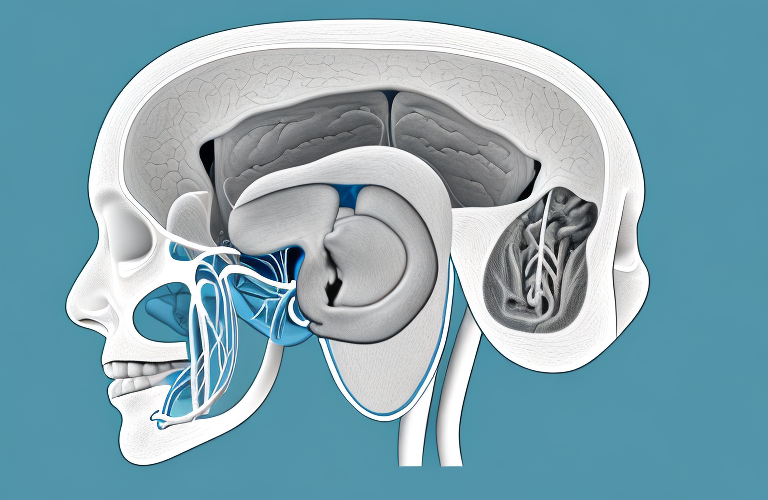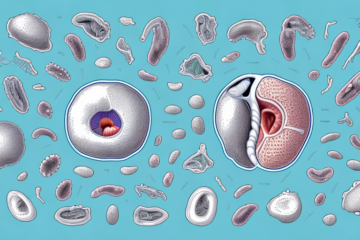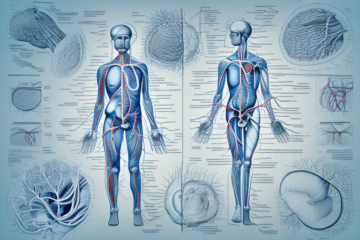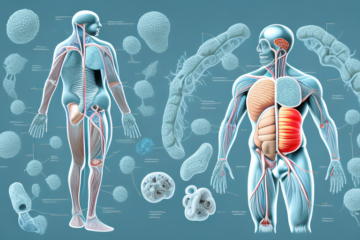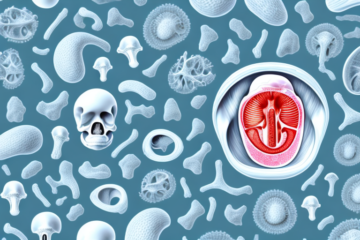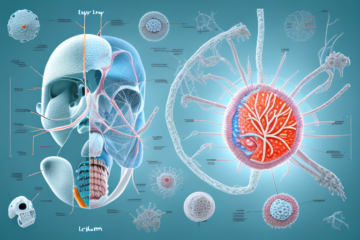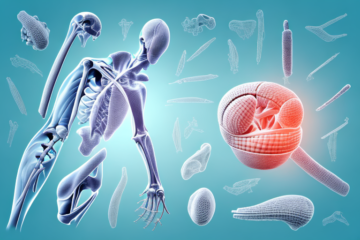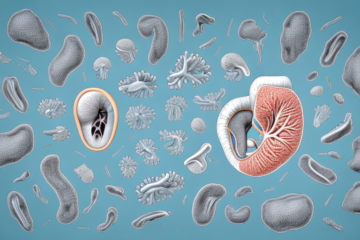The ear is a complex sensory organ that performs the crucial function of hearing and maintaining balance. It comprises three main sections- the outer ear, the middle ear, and the inner ear- each with unique structures and functions that work together in the process of hearing. In this article, we will explore the basic anatomy and functioning of the ear, common ear problems, and how to keep your ears healthy and safe.
Understanding the Basic Anatomy of the Ear
The outer ear, also known as the pinna or auricle, is the visible part of the ear that collects sound waves and directs them towards the ear canal. The ear canal is a narrow tube that leads to the eardrum, a thin membrane that separates the outer ear from the middle ear.The middle ear is an air-filled space behind the eardrum that contains three tiny bones- the hammer, anvil, and stirrup- which amplify and transmit sound vibrations to the inner ear. This section also has a narrow tube called the Eustachian tube that connects the middle ear to the back of the nose and helps regulate air pressure.The inner ear, which is located deep within the skull, contains the cochlea, a fluid-filled structure that converts sound vibrations into electrical signals that the brain can interpret. It also houses the semicircular canals, which are responsible for detecting head movements and maintaining balance.
The anatomy of the ear is incredibly complex and fascinating. The outer ear, for example, is not just a passive collector of sound waves. It also plays an important role in localizing sounds, helping us to determine where a sound is coming from. This is achieved through the shape of the pinna, which creates subtle differences in the way sound waves arrive at the ear canal depending on their direction.
Another interesting fact about the ear is that it is capable of amplifying sounds by up to 60 decibels. This is achieved through the action of the three tiny bones in the middle ear, which work together like a lever system to increase the force of sound vibrations. Without this amplification, many sounds would be too quiet for us to hear, especially in noisy environments.
How the Ears Work – Explained in Simple Terms
The process of hearing begins when sound waves enter the ear canal and vibrate the eardrum. These vibrations are then transmitted by the three tiny bones in the middle ear to the cochlea in the inner ear. The cochlea’s sensory cells pick up the vibrations and convert them into electrical signals, which are then sent to the brain through the auditory nerve for interpretation.The inner ear also plays a crucial role in maintaining balance. The semicircular canals, which are filled with a fluid that moves in response to head movements, send signals to the brain that help maintain balance and orientation in space.
In addition to hearing and balance, the ears also play a role in regulating pressure. The Eustachian tube connects the middle ear to the back of the throat and helps equalize pressure on both sides of the eardrum. This is why you may feel the need to “pop” your ears when flying or driving up a mountain.
It’s important to take care of your ears to prevent hearing loss and other issues. This includes avoiding loud noises, wearing ear protection when necessary, and cleaning your ears properly (avoid using cotton swabs!). Regular check-ups with an audiologist can also help detect any problems early on.
The Different Parts of the Ear and their Functions
Each part of the ear has a unique structure and function that contributes to overall hearing and balance. The outer ear is primarily responsible for collecting sound waves and directing them towards the ear canal, while the middle ear amplifies and transmits these vibrations to the inner ear. The inner ear then processes the vibrations into electrical signals that the brain can interpret.The Eustachian tube, located in the middle ear, is also an essential part of the ear’s function as it helps equalize air pressure in the middle ear, which is crucial for comfortable hearing.
In addition to its role in hearing, the inner ear also plays a crucial role in balance. The vestibular system, located in the inner ear, is responsible for detecting changes in head position and movement, and relaying this information to the brain to help maintain balance and coordination.
It is important to take care of your ears to maintain their function. Exposure to loud noises, such as music or machinery, can damage the delicate structures of the ear and lead to hearing loss. Regular cleaning of the outer ear can also help prevent infections and maintain proper function.
The Role of the Outer Ear in Sound Perception
The outer ear is responsible for collecting and funneling sound waves towards the ear canal. It includes the pinna or auricle, which helps capture sound waves and direct them to the ear canal, and the ear canal, which is a narrow passage that amplifies sound.The shape and size of the outer ear play a critical role in how we perceive sound. For example, the ability to localize sound- to determine where a sound is originating from- is largely due to the nature of the outer ear’s shape and the way sound waves interact with it.
In addition to its role in sound collection and localization, the outer ear also plays a role in protecting the inner ear from damage. The pinna helps to shield the ear canal from foreign objects, such as insects or debris, that could potentially cause harm to the delicate structures of the inner ear.
Furthermore, the outer ear can also affect the quality of sound that we hear. The shape and size of the pinna can alter the frequency response of sound waves, which can impact the perceived loudness and clarity of certain sounds. This is why some individuals may have difficulty hearing certain frequencies or may require hearing aids that are specifically designed to amplify certain ranges of sound.
Exploring the Middle Ear and its Functioning
The middle ear is an air-filled cavity located behind the eardrum. It contains three tiny bones- the hammer, anvil, and stirrup- that are responsible for amplifying sound vibrations and transmitting them to the inner ear. The middle ear also includes the Eustachian tube, which is responsible for regulating air pressure in the middle ear and maintaining comfortable hearing.Middle ear infections are common, especially in children. These infections cause inflammation and fluid buildup in the middle ear, leading to temporary hearing loss and ear pain. In severe cases, the fluid may need to be drained to relieve pressure and restore hearing.
Aside from its role in hearing, the middle ear also plays a crucial role in balance. The vestibular system, which is located in the inner ear, is responsible for maintaining balance and spatial orientation. The middle ear helps to transmit information from the vestibular system to the brain, allowing us to maintain our balance and sense of direction.
There are several factors that can affect the functioning of the middle ear. Exposure to loud noises, certain medications, and infections can all cause damage to the middle ear and lead to hearing loss. It is important to protect your ears from loud noises and to seek medical attention if you experience any symptoms of an ear infection or hearing loss.
Delving into the Inner Ear and its Complexities
The inner ear is the most complex part of the ear and is responsible for converting sound vibrations into electrical signals that the brain can interpret. It includes the cochlea, a fluid-filled structure that contains sensory cells known as hair cells. These hair cells pick up the vibrations and convert them into electrical signals that travel through the auditory nerve to the brain.The inner ear is also crucial for maintaining balance and orientation. The semicircular canals, located in the inner ear, detect head movements and send signals to the brain that help maintain balance and posture.
In addition to its role in hearing and balance, the inner ear also plays a key role in regulating our body’s response to stress. The inner ear contains a small organ called the utricle, which is responsible for detecting changes in gravity and acceleration. This information is sent to the brain, which then triggers the release of stress hormones such as cortisol. This response is important for our survival, as it helps us to react quickly to potential threats or danger.
Hearing Loss: Causes, Symptoms, and Prevention
Hearing loss is a common problem that affects millions of people worldwide. It can be caused by a variety of factors, including age, genetics, exposure to loud noise, infections, and certain medications.Symptoms of hearing loss may include difficulty hearing speech in noisy environments, tinnitus (ringing in the ears), and the need to turn up the volume on electronics and appliances. Preventative measures, such as protecting your ears from loud noises and getting regular hearing tests, can help minimize the risk of hearing loss.
In addition to preventative measures, there are also various treatment options available for those who have already experienced hearing loss. These may include hearing aids, cochlear implants, and assistive listening devices. It is important to consult with a healthcare professional to determine the best course of action for your individual needs.
The Importance of Regular Hearing Tests for Maintaining Good Hearing Health
Regular hearing tests are an essential aspect of maintaining good hearing health. These tests can detect hearing loss in its early stages, allowing for prompt treatment and management. It is recommended that adults get their hearing tested at least once every ten years until age 50, and then once every three years thereafter.Children should also undergo regular hearing screenings, starting at birth and continuing through childhood. Early detection and treatment of hearing loss can ensure better outcomes and improve quality of life.
In addition to detecting hearing loss, regular hearing tests can also help identify other underlying health conditions that may affect hearing, such as high blood pressure or diabetes. These tests can also provide valuable information for individuals who work in noisy environments or participate in loud recreational activities, as they may be at a higher risk for hearing damage. By getting regular hearing tests, individuals can take proactive steps to protect their hearing and overall health.
Common Ear Problems and Their Management
Ear problems can be uncomfortable and even painful. Common ear problems include ear infections, impacted earwax, tinnitus, and hearing loss.Treatment for ear problems will depend on the specific condition and its severity. In some cases, simple measures such as warm compresses or over-the-counter pain medications may be sufficient. In other cases, prescription medications or surgical intervention may be necessary.
It is important to note that prevention is key when it comes to ear problems. Avoiding exposure to loud noises, practicing good ear hygiene, and seeking prompt treatment for any ear infections can all help prevent future ear problems. Additionally, regular check-ups with an audiologist can help detect any hearing loss early on, allowing for timely intervention and management.
How to Clean Your Ears Safely and Effectively
Cleaning your ears is essential for maintaining good hygiene and preventing ear infections. However, it is essential to clean your ears safely and effectively to avoid causing damage to the delicate structures of the ear.Some safe and effective methods for cleaning your ears include using a warm, damp cloth to wipe away excess earwax or using an earwax removal kit. Avoid using Q-tips or other objects inside the ear canal, as this can push earwax further into the canal and potentially damage the ear.
It is also important to note that some people may produce more earwax than others, and excessive earwax buildup can lead to hearing loss or discomfort. If you experience symptoms such as ear pain, itching, or difficulty hearing, it is best to consult a healthcare professional for advice on safe and effective ear cleaning methods. They may recommend ear drops or irrigation to help remove excess earwax and improve your ear health.
Tips for Protecting Your Ears from Loud Noises
Exposure to loud noises, even for short periods, can cause hearing damage and even permanent hearing loss. It’s important to protect your ears from loud noises as much as possible.Some tips for protecting your ears include using earplugs or noise-cancelling headphones in loud environments, lowering the volume on headphones and electronics, and taking breaks from loud noises. In addition, regular hearing tests can help detect any early signs of hearing damage and prevent further hearing loss.
Another way to protect your ears is to be aware of the noise levels in your environment. If you’re in a loud environment, try to move away from the source of the noise or take a break in a quieter area. It’s also important to limit your exposure to loud noises, especially if you work in a noisy environment. Consider taking breaks throughout the day to give your ears a rest.
Finally, it’s important to educate others about the importance of protecting their ears from loud noises. Encourage your friends and family to use earplugs or noise-cancelling headphones when attending concerts or other loud events. By spreading awareness about the dangers of loud noises, we can all work together to protect our hearing and prevent hearing loss.
Understanding Tinnitus: Causes, Symptoms, and Treatment Options
Tinnitus is a common condition that causes a ringing, buzzing, or humming sound in the ears. It can be caused by many factors, including age-related hearing loss, exposure to loud noise, ear infections, and certain medications.Treatment for tinnitus will depend on the underlying cause and severity of the condition. Some treatment options for tinnitus include sound therapy, cognitive behavioral therapy, and the use of hearing aids or other assistive devices.
It is important to note that tinnitus can also be a symptom of a more serious underlying condition, such as a tumor or head injury. Therefore, it is crucial to seek medical attention if you experience tinnitus along with other symptoms such as dizziness, headaches, or changes in vision.
Additionally, lifestyle changes such as reducing exposure to loud noises, managing stress levels, and avoiding certain foods and drinks (such as caffeine and alcohol) may also help alleviate tinnitus symptoms. It is important to work with a healthcare professional to determine the best course of treatment for your individual needs.
What You Need to Know About Hearing Aids – Types, Features, and Benefits
Hearing aids are devices that can help improve hearing for people with hearing loss. There are many different types of hearing aids available, from behind-the-ear models to completely-in-canal models.Features of hearing aids can include directional microphones, noise reduction, feedback suppression, and Bluetooth connectivity. Benefits of hearing aids include improved hearing in various environments, better communication with others, and improved quality of life for people with hearing loss.
It is important to note that hearing aids are not a one-size-fits-all solution. The type of hearing aid that is best for you will depend on the severity and type of your hearing loss, as well as your lifestyle and personal preferences. It is recommended that you consult with an audiologist to determine the best hearing aid for your individual needs.
Future Directions in Ear Research: Advances in Technology and Treatment Options
Research into the ear and hearing continues to advance, with new technologies and treatment options constantly being developed. Some of the exciting advances in this field include cochlear implants, gene therapy for hearing loss, and improved hearing aid technology.As researchers continue to uncover the complexities of the ear and its functions, there is hope for better treatment and management options for people with hearing loss and other ear conditions.
One area of research that shows promise is the use of stem cells to regenerate damaged or lost hair cells in the inner ear. These hair cells are crucial for hearing, and their loss is a common cause of hearing loss. By using stem cells to regenerate these cells, researchers hope to restore hearing in people with certain types of hearing loss.
Another area of research is focused on developing new drugs to treat inner ear disorders. These drugs would target specific proteins or molecules involved in the ear’s functions, and could potentially provide more effective and targeted treatment options for conditions such as tinnitus or Meniere’s disease.
Conclusion
The ear is a complex organ that performs the essential functions of hearing and maintaining balance. Understanding the anatomy and function of the ear, common ear problems, and preventative measures to protect your ears can help maintain good hearing health. With continued research and advancements in technology and treatment options, there is hope for better outcomes and improved quality of life for people with ear conditions.
It is important to note that exposure to loud noises can cause irreversible damage to the ear. This can lead to hearing loss and tinnitus, a ringing or buzzing sound in the ear. It is recommended to wear ear protection in loud environments, such as concerts or construction sites, and to limit exposure to loud noises whenever possible. By taking these precautions, we can help preserve our hearing and prevent potential hearing problems in the future.

